Shot in CinemaScope, 'La La Land' vibrantly romances the olden days of Hollywood
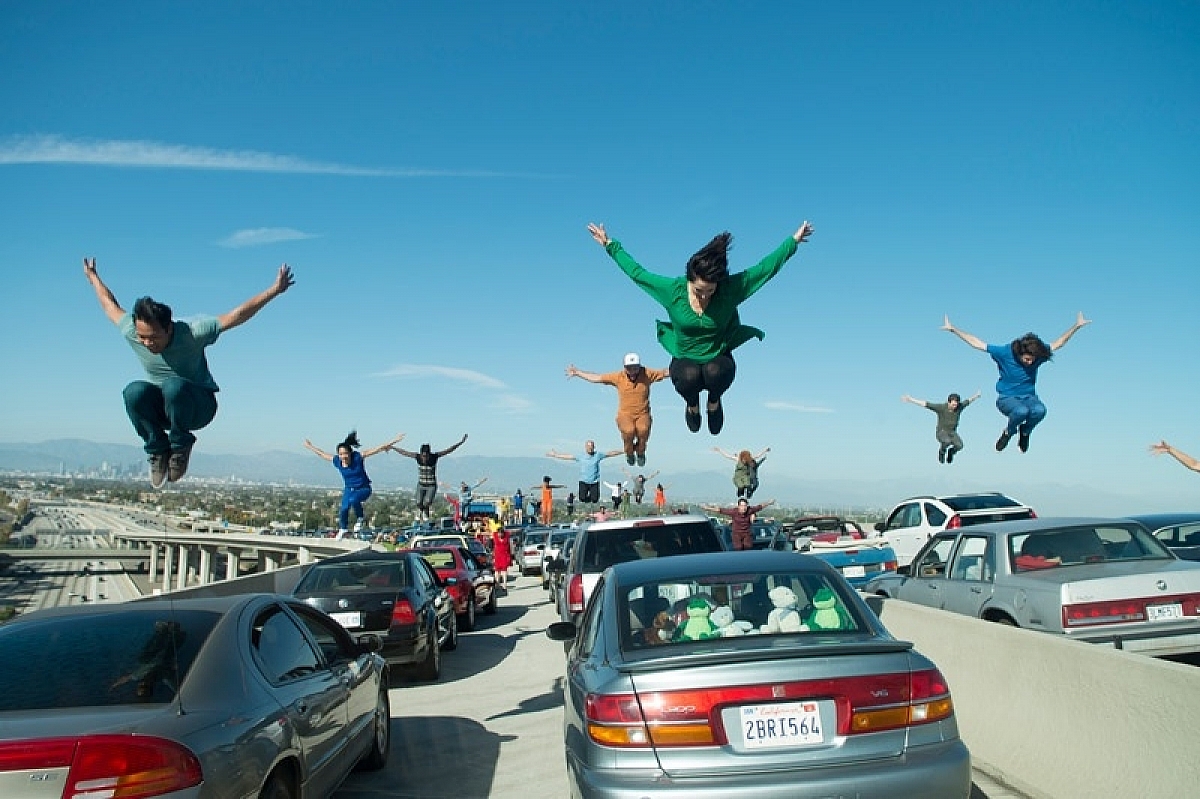
The cast of "LA LA LAND." Photo Credit: Dale Robinette.
It looks like a bright, hot summer day on a Los Angeles highway, where scores of drivers are stuck in early morning traffic listening to various tunes on their radios. But as a hilarious title card would inform us in just a few moments, this is winter in LA. It’s “Another Day of Sun,” where people can drive with their windows rolled down year-around, perhaps exasperated in road rage but ultimately happy and hopeful enough to pop out of their vehicles and launch into an exuberant song and dance number. This is the start of writer-director Damien Chazelle’s exquisite La La Land in a nutshell; one of the best openings of 2016 that won’t be erased from memories any time soon.
This opening is also a stage where Mia (Emma Stone) and Sebastian (Ryan Gosling) would meet-cute in just a few moments. The former is a starlet and aspiring playwright. The latter is a jazz pianist who wants to open up his own club one day. They fall in love, creatively lift each other up and eventually realize their dreams are incompatible with their flourishing love. La La Land is happy and sad, joyous and tear-jerking, bright and moody: a package of emotional and visual contrasts as harmonious as Justin Hurwitz’ compositions. And it is vibrantly shot on film by renowned cinematographer Linus Sandgren, with whom we recently had an in-depth conversation, dissecting La La Land both visually and philosophically.
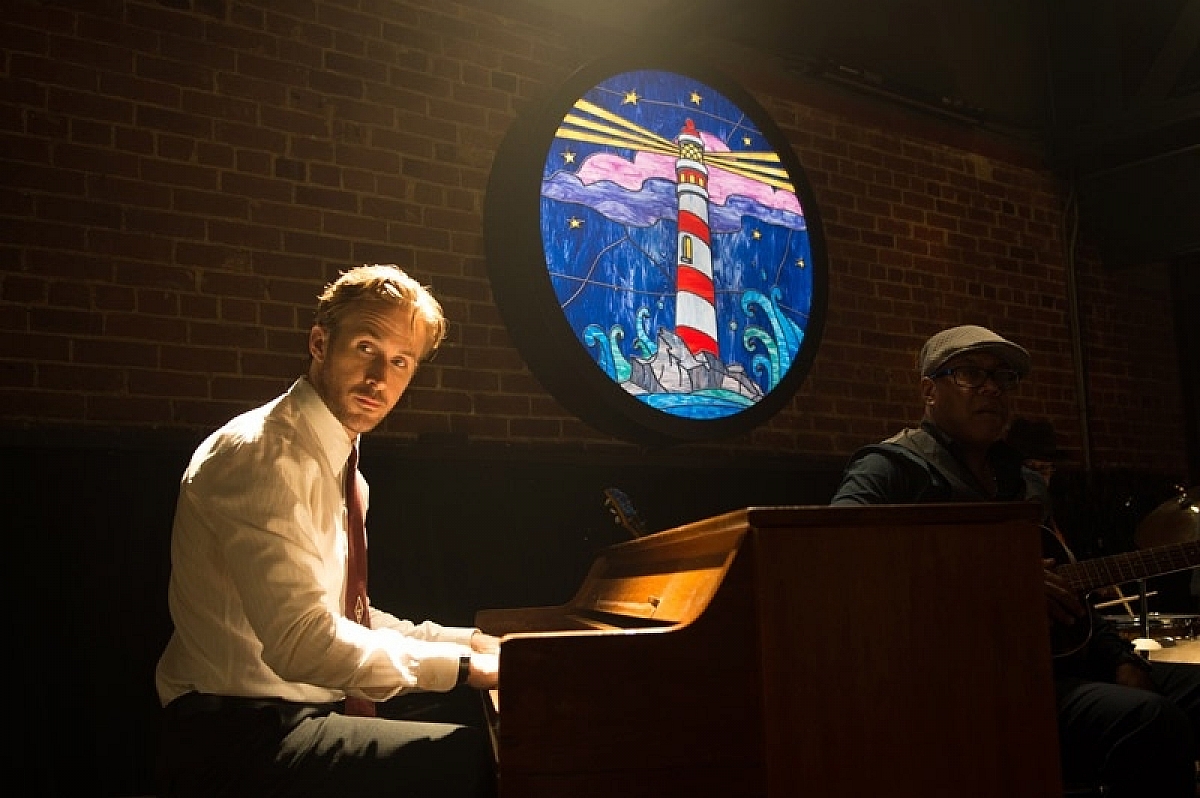
Ryan Gosling stars as ‘Sebastian’ in "LA LA LAND." Photo Credit: Dale Robinette
“La La Land is a contemporary story about dreamers, but Damien wanted to tell it in the vein of an older Hollywood musical, inspired by old Hollywood filmmaking,” says Sandgren, explaining the reason why they chose to shoot it in CinemaScope. “We asked Panavision [Dan Sasaki] to make new ground glasses for us. They also made us special anamorphic lenses. We shot the majority of the film in s35mm 2x anamorphic 4-perf 2.55:1 CinemaScope. Damien really wanted to shoot anamorphic lenses because he loves the aspect ratio and all the bokeh distortion they give. I proposed we should go for CinemaScope 2.55 like Cukor's A Star is Born from 1954 and other films from that era, when anamorphic cinematography was introduced.”
Sandgren says they ended up shooting all exterior daytimes on KODAK VISION3 250D Color Negative Film 5207, which they rated 100 ASA and pull processed -1 stop for finer grain and softer contrast. All interiors day and night and all dusks and nights were shot on KODAK VISION3 500T Color Negative Film 5219, rated 200 ASA and pull processed -1 stop for finer grain and softer contrast.
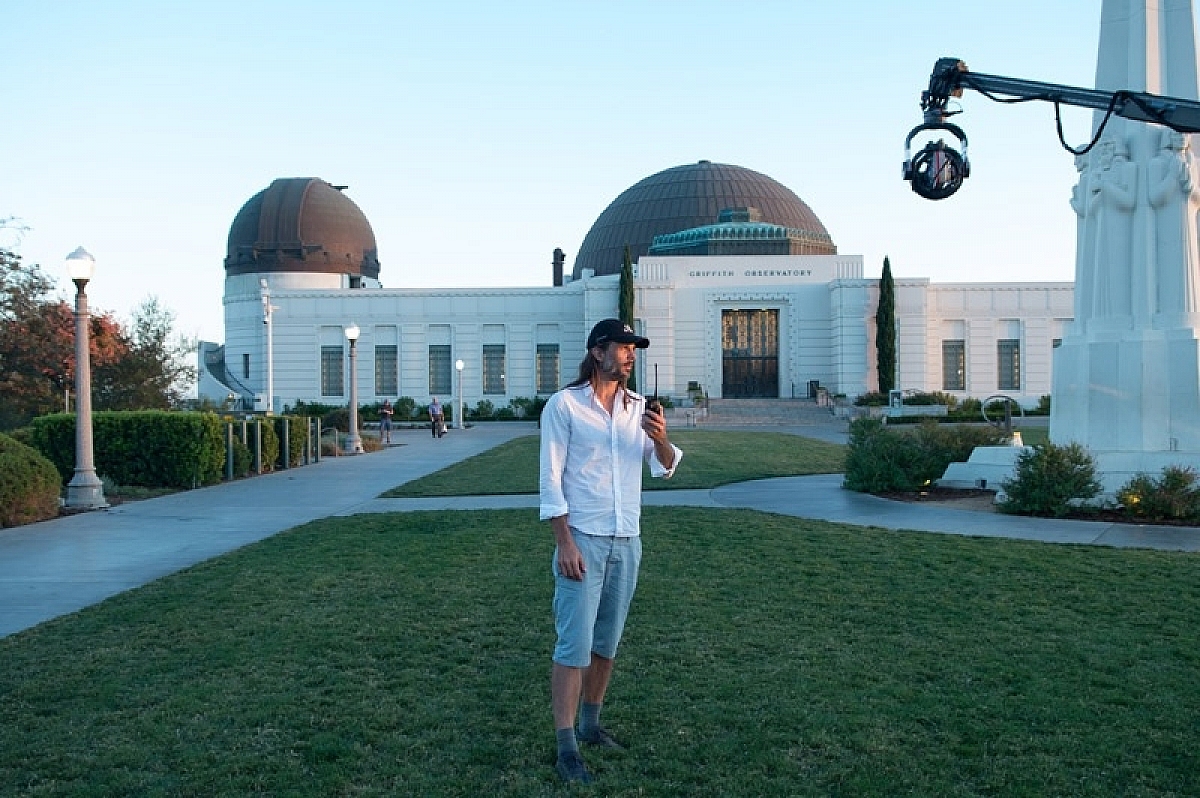
Cinematographer Linus Sandgren, FSF on the set of "LA LA LAND." Copyright Lions Gate.
For the special sequence in the epilogue where Sebastian and Mia sit down to see their "home made films" on a projector, they shot 16mm anamorphic on the KODAK VISION3 250D Color Negative Film 7207. Sandgren fondly remembers the details of a happy accident involving that scene, which charges the moment with a new level of emotional force. “[You see that] the film jumps a little [in that scene]. And that really happened when the camera accidentally jammed. And Damien used the jammed part in the film. That is an example of what wouldn't have been possible in digital, you know.”
Below is an edited version of our in-depth conversation with Linus Sandgren.
Let’s start from the beginning. How did you meet Damien? And when did you realize your visions basically clicked?
We had a meeting that was supposed to be an hour, and it became a longer, very inspiring meeting. I didn't know anything about the music beforehand. I had read the script, but then he played the music for me, and it really emotionally touched me. Damien was instantly making me inspired with his enthusiasm and clear vision. What we had in common was the love for the craft of filmmaking and for the heritage of old things. We both have an old-school mindset. Both of us felt that celluloid film was the obvious choice of format to capture the richest possible image.
In the industry now, there is a rush to develop digital technology. They are embracing it because it’s new, but if you want to work with perfection, you should probably go back to where we are with film cameras and perfect that. We can't forget that it's also an art form.
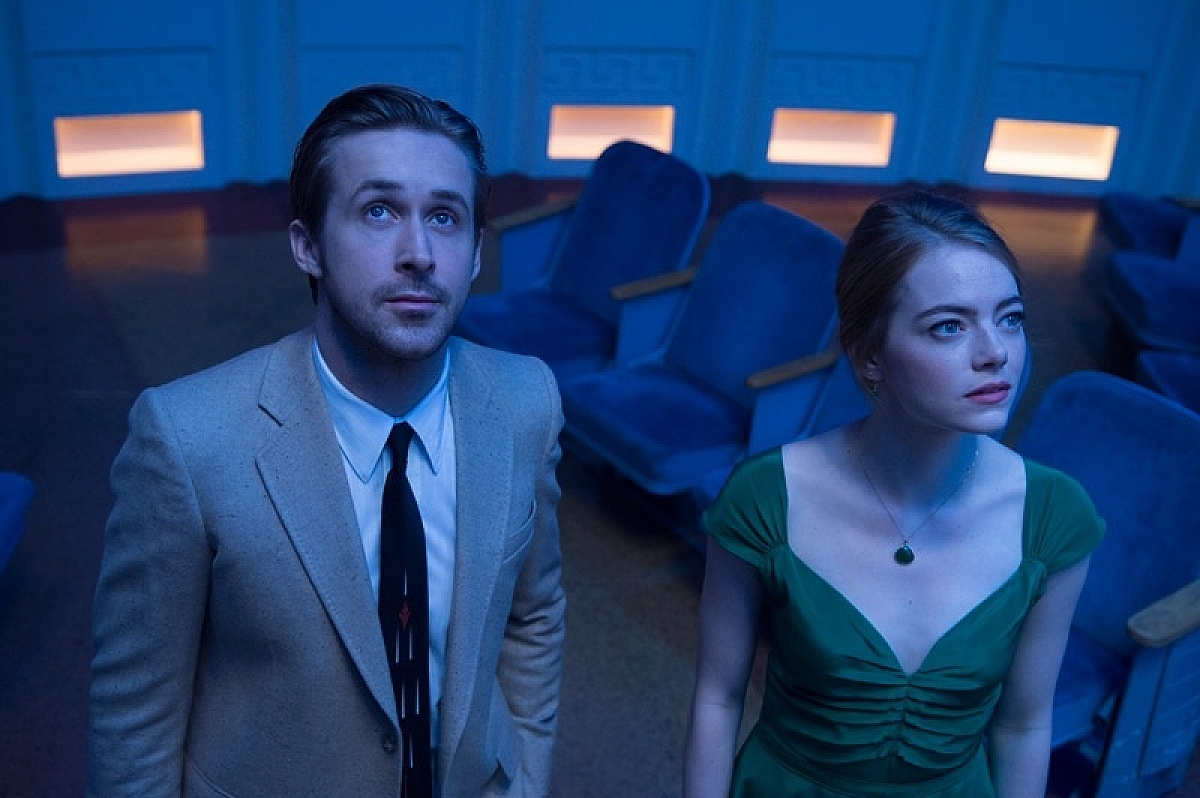
Emma Stone and Ryan Gosling on the set of "LA LA LAND." Photo Credit: Dale Robinette
"La La Land" is a very colorful film. It looks like “candy” for lack of a better analogy, and it makes you want to lick the screen almost. All those rainbow of colors… they really, really pop.
Absolutely, and it’s thanks to film. If you look at [other films I shot, like] American Hustle and Hundred Foot Journey also…I love to work with colors that you don't always see with your eyes, but that I know is captured by the film stocks. If you work with cool lights – fluorescents or mercury vapor streetlights – they tend to become much more aqua colored at night on film, and it captures much more of the richness for the skies. When you see La La Land, all the colors in the film are real. The color separation and rich nuances is what the celluloid film captured, and the saturation in the DI is on a normal level. To achieve this level of saturation in digital, you would've had to boost saturation in the DI, but the variety of colors wouldn't have been present in the digital neg.
At night, we worked a lot with the green blue colors in contrast and complementary to the pink magic hour skies. The blue nights, we captured in twilight. That's all real. You may think we replaced the sky in the big dance number they do on Mulholland Drive since it looks surreal, but in fact, we spent the magic hour nights to find the perfect moment of the sky. I look at the difference between film and digital like this: If you say film is like a classic painting of a face, where the beige skin tone would be achieved by strokes of purples, yellows, reds, greens and blues, digital would be like cheating to save data. So it bases the skin tone on three colors. [Film stock, on the other hand] has much more complex color variations in it. That’s how it works.
I was so glad when we went out on the pier with Ryan Gosling when he sings by himself, and also the moment before they separate in front of a lighthouse. We set up the camera to wait for the light to be that light we had there. It's such a subtle soft light. And thanks to the film stock, the scene has incredible variations of colors in the sky, the building, the street and the skin tones.
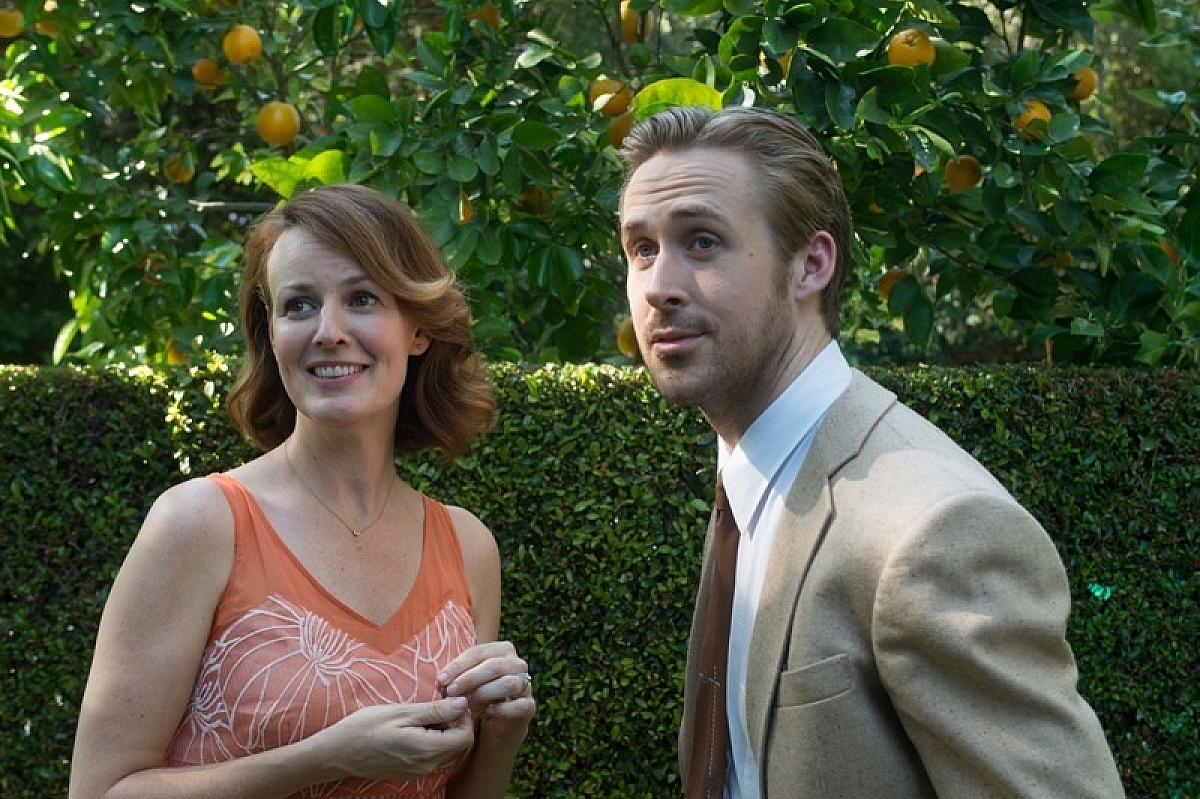
Laura (Rosemarie Dewitt) and Sebastian (Ryan Gosling) in "LA LA LAND." Photo Credit: Dale Robinette
Were there any challenges around getting the dailies? What was that process like?
We shot in LA, and the best lab we have in America – FotoKem – is in LA. So it was both great and practical. But since we pull processed, they just assigned a specific time of day when they did pull processing. Then in the early morning, it was scanned by Efilm. I have this routine since Joy. My colorist Matt Wallach at EC3 Labs (Efilm) sends me still frames from his telecine for me to approve on a calibrated iPad, so that he could print the dailies for editorial in the morning after a shoot day.
There is often this discussion about film vs. digital. On American Hustle, on The Hundred Foot Journey, on The Nutcracker and the Four Realms [Lasse Hallström]…the same worries have been brought up in prep about shooting film: about time, post, shooting flexibility and of course budget. But with proper open-minded comparisons, there has not been enough advantage for digital in these films. And since aesthetic advantage of film has been superior, that has, after we performed tests, always been everyone's preference. Even now on The Nutcracker and the Four Realms, they leaned toward shooting digital [at first]. We did look tests and found no technical advantages, so we eventually shot s35mm film, as well as 65mm. All my films have shot on film except for one Swedish movie. A cinematographer can simply do more with film.
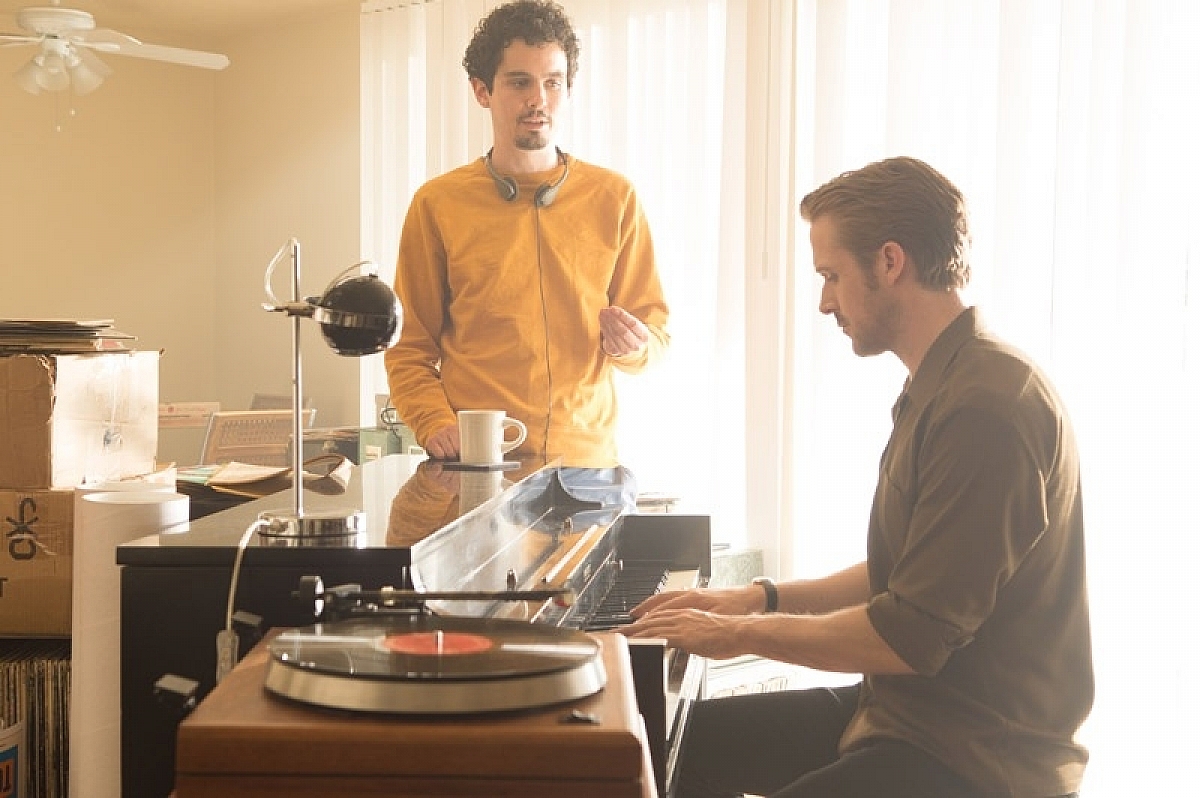
Director Damien Chazelle (left) and Ryan Gosling (right) on the set of "LA LA LAND." Photo Credit: Dale Robinette
It also sounds like there's a sense of discipline that shooting on film brings to the set and the overall process.
Absolutely. There are many aspects of why you should shoot film. One argument for digital is that you can roll for 30 minutes on a mag, saving reloads. No need for cutting camera. But I actually think it's terrible to have actors act for even 20 minutes without a break. And with my team, we never reload for longer than 30 seconds to a minute; it's quick reloads. While the director's talking to the actor, you reload. It's normal. Also, it’s not more expensive to shoot film now than it was 10 years ago, so why not shoot film? On digital, you would have to pay for other labor like DITs and still need to do dailies. But the foremost benefit for me is celluloid captures colors and contrast completely differently than digital cameras. There are numerous ways to treat film stock to make it look very different, and I think that’s obvious to every cinematographer.
When I saw this movie, I really fell for LA and the idea that it was this beautiful, magical place.
That was an interesting discussion Damien and I had on the first meeting. I moved to LA from Sweden. I am a person who really loves the nature. California has amazing nature. Even in urban LA, on a street like Lincoln Boulevard or Santa Monica Boulevard in Hollywood (which anyone would say is an ugly, gritty street with telephone poles) in the magic hour after sunset, there is a very interesting contrast between the urban grit and the nature. Both Damien and I have a huge appreciation of that.
Did you two have a checklist of favorite musicals or other art you wanted to draw inspiration from?
I think Damien had a list of like a million movies to watch. He is a cineaste, and I am a cineaste too, but he has seen all the musicals in the whole world. We watched classics like Bandwagon, An American in Paris, Singin’ in the Rain and also French films like Jacques Demy's The Umbrellas of Cherbourg. A Star Is Born was as much an inspiration for color. A lot of the older musicals were often just panning or tracking sideways, but we were more physically involved, in the depth, vertical and circling around, I think.
I also was inspired by [painter Edward] Hopper for the minimalistic simplicity of lighting and by Todd Hido's photography for magic mood. But I also turned to some other house gods of mine when I put together mood boards in preproduction, mostly painters and photographers from the 70s.
An important factor for this film was to make reality less real, to travel between reality and dream seamlessly, or at the same time. Production Designer David Wasco and Set Decorator Sandy Wasco had this set of gas-light-looking street lights that we kept using on various locations to create a romantic and timeless look.
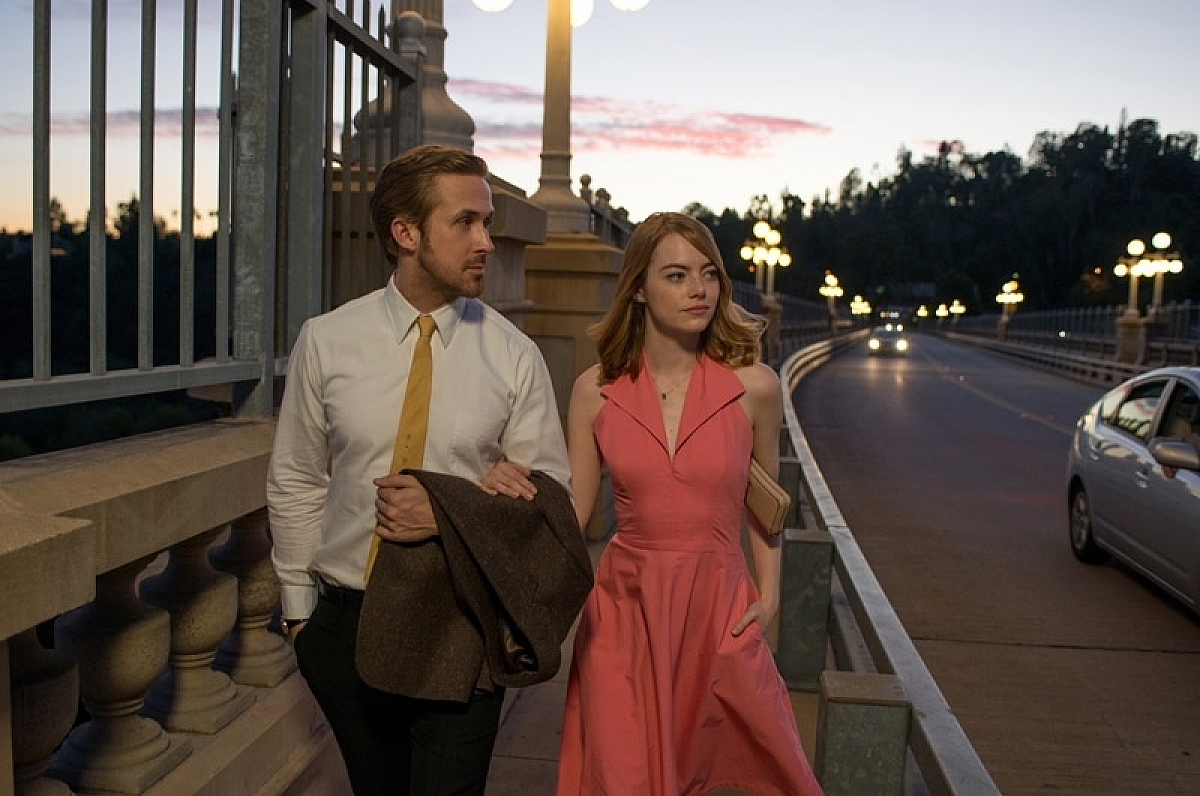
Sebastian (Ryan Gosling) and Mia (Emma Stone) in "LA LA LAND." Photo Credit: Dale Robinette
That romantic approach is so palpable that you find it even in the traffic jam in the opening. To ask a really broad question, how did you shoot that very challenging scene?
Well, the choreography of dancers posed technical problems. Since we needed to shoot one single take in the traffic jam, the choreography had to be in a certain way. We had to have a certain path for the camera. It’s a chain reaction of complicated technical obstacles when you do a film like this. We planned it out on a parking lot at our production office and worked out how the camera should move around on a Steadicam. But when we found that location with a divider in the middle of the road, I realized there was no way we could shoot that entire thing on a Steadicam because the divider would prevent us from getting through. Instead, we figured we had to shoot it on a telescoping crane. But then the crane would still not reach enough, so we had to put the crane on a platform that could move, and the platform had to be able to carry a big crane. I had frequently used Allan Padelford's Biscuit Jr. rig mostly for car work, but also for intricate specialty shots like crane shots. It's like a drivable process trailer that we used as a huge dolly on which we put a 50-foot techno to do the moves. Then, because it was a crane arm that was going to move in big circular moves, it would cause shadows on the cast, so we had to rethink the choreography and also the time of day to shoot it. We decided to make two simple hidden cuts in whip pans. So the actual dance sequence is in three parts.
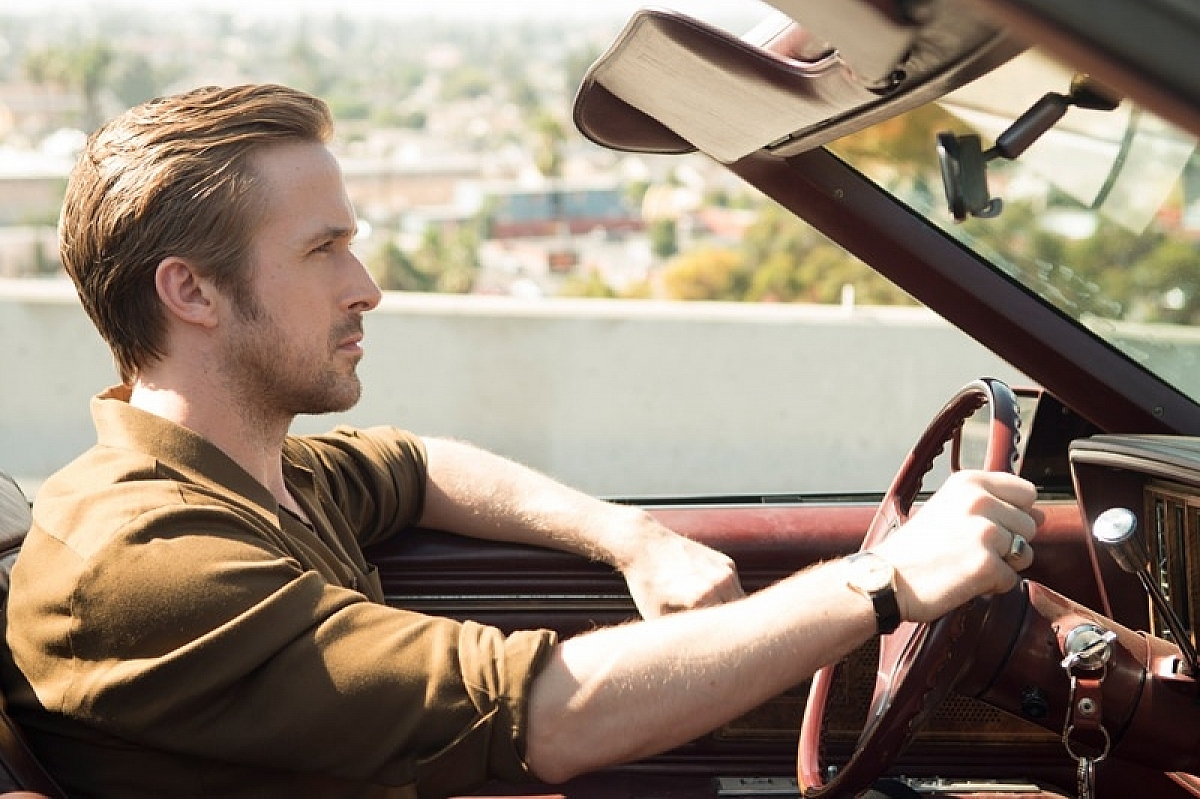
Ryan Gosling stars as 'Sebastian' in "La La Land." Photo Credit: Dale Robinette
At what points did you cut?
The shot starts in the sky, tilts down and we travel along cars by backing up the Biscuit Jr. and Crane rig. Then we end up on this girl that comes out of the car and starts singing. We then drive the rig forward with the camera hanging between cars two rows away from the rig, leading the cast between the cars until we whip pan left 180 deg. In that pan, we cut. Then, it's one sequence on the Crane all the way around that car with the girls coming out, and then back over the convertible, and then this person doing a flip. We track in on the guy who then takes us across. Biscuit Jr. backs up and then drives forward, while crane moves, arms left. It is all one long take up until after when everyone is dancing behind the van, when the camera pans left and lands on the girl that we started on, laying on the car. In that cut, we cut to a Steadicam, which takes us between the cars and ends up turning around and backing up on a crane that we were hiding in the shot behind a van. When you look down towards the van, the crane is behind it hiding and as soon as the camera turns around to look at the parkour guy, he backs up and this crane comes pushed in by the grips. He gets up on this crane and the crane goes up in the air. Then, up in the air is a title card, and in the title card we actually have the hidden cuts. The crane goes down and finds Ryan and Emma, and then it's a cut to the mirror shot when she sees Ryan.
We shot, I think, 25 or 27 takes with the Steadicam in full sun, and we also were chasing the sun because there were a lot of clouds. The first day was full of clouds. So we had a problem to start shooting because we were not getting sun and the song is about sun.
Some would assume, falsely probably, that if that scene had been shot on video, it would have been easier.
I mean, it wasn't really a technical limitation to shoot on film because you still would have needed a crane, or you would have needed a Steadicam with a camera on it, because we couldn't have been precise enough to shoot this scene with a drone or RC helicopter.
We couldn't have shot it with a Movi rig in a proper way because we wanted to get up high. So we wouldn't have benefited from a digital camera. Then also for the look, we would have lost so much that it wouldn't have been worth it. And [in] my experience, there's always a solution for film cameras.
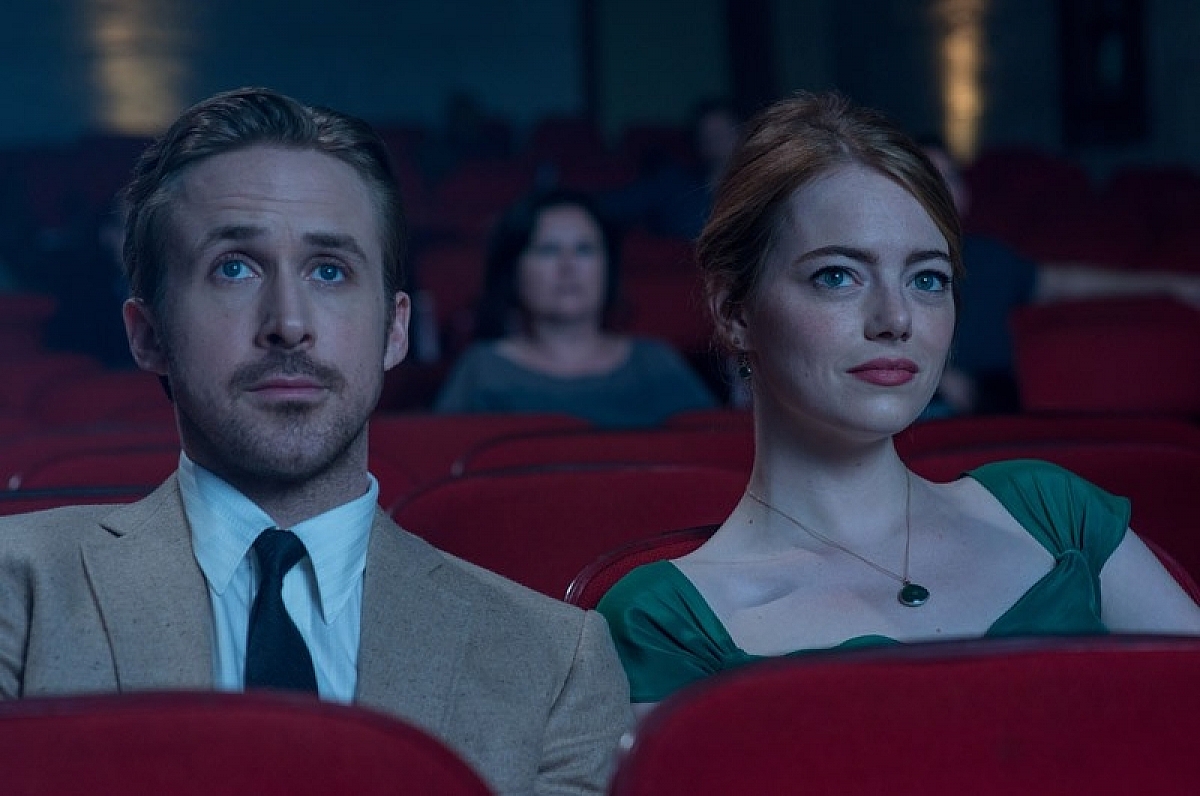
Sebastian (Ryan Gosling) and Mia (Emma Stone) in "LA LA LAND." Photo Credit: Dale Robinette
Do you have a favorite sequence or shot in "La La Land"?
I really love the sequence when they meet at the cinema. I think with the projection on her face and all the effects in there, like the projector and the light effect on them. It's either that or it's the sequence of him playing piano in the Italian restaurant. He was so good. You know Ryan plays for real?
I know, but I also read he did not play the piano before, so he learned and practiced for this movie.
Yes, he got hooked for life I think. Both Emma and Ryan practiced dance, song and piano playing for three months. The two of them were so dedicated to the project – very inclusive and collaborative. And that in itself was incredibly inspiring for the rest of us.